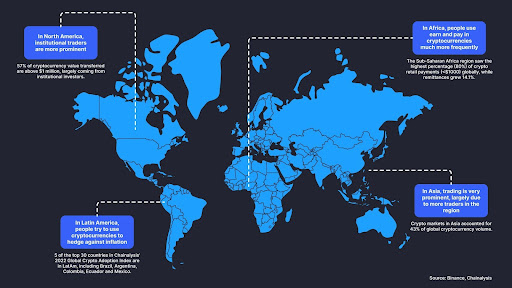
CoinMarketCap sat down with Binance CEO and founder Changpeng “CZ” Zhao to discuss the future outlook for crypto adoption in 2023.
Measuring Adoption in An Eventful Year: 2022
CMC: In 2022, we’ve seen the fall of many big players — 3AC, Luna, Celsius, Voyager, FTX — how much have these collapses affected the industry in terms of user adoption? And how do you go about measuring crypto adoption in general?
CZ: 2022 is definitely not a good year. A lot of negative things have happened.
Usually, the way I look at the measure of adoption is actually just the Bitcoin price, which usually is a fairly accurate indicator of the industry.
Historically, Binance’s user registration rate, trading volume, etc. have all been very heavily correlated with Bitcoin’s price: that line is actually the same shape as almost every other indicator that we use.
Right now, Binance trading volume is about a third of what it was a year ago, when Bitcoin’s price was near its all-time-high [of $68,800]. All these events have slowed down the industry, creating a negative impact.

The entire crypto industry goes through four-year cycles. Every four years, there’s a bear market. I think we are in one now: bear markets have historically lasted about a year, and we are now about a year out from the last all time high.
Nexteth Wave of User Adoption
CMC: What do you think the crypto industry can do concretely to bring on the next wave of user adoption? It is about building more user-friendly DeFi solutions? Is the solution regulating more centralized crypto providers? Are there any other avenues you see to bring more people on board to crypto next year?
CZ: The more we build applications that people use, the better. It’s that simple. If you look at the internet and how it’s grown, many different people build different apps that leverage the internet. Today, we don’t even talk about the Internet anymore: we just use whatever app that people are using.
It’s a similar thing in crypto with DeFi, CeFi, wallets, faster blockchains, education, regulatory improvements, etc. All of those things will help. Regulatory clarity is very important: given the negative instances that happened in the industry, we have to become more transparent and build more trust. I think the industry will have to shift towards a much more transparency-based system, one that users can verify.
Given the issues with the centralized exchanges recently, more people will shift to DeFi. But then there will be a hack, there will be a rug pull in DeFi, somebody will have lost a lot of money in DeFi and then the people will move back towards centralized exchanges. The industry moves incrementally in many different aspects at the same time.
CMC: If you had to choose what would be more important for adoption — building those new products or increasing regulation and transparency — which one do you think has more relevance?
CZ: For adoption, I believe products have more influence. For example, how do we make it easy for normal people to hold their private keys securely themselves, and more practically: when they become unavailable, how do their loved ones get access? Regulatory clarity is important, and also helps adoption. But at the end of the day, it’s products.
Rebuilding in A Bear Market
CMC: Binance is like a microcosm of the industry at large — you have retail users with the spot exchange business, you have institution clients with the futures product, custody and the venture side. With the different types of clients and users, which area will be the most challenging for the industry to rebuild trust in and increase adoption post-2022?
CZ: We’ve seen that more people move to their own wallets. TrustWallet is growing quite quickly versus the centralized Binance.com exchange. The institutional business, Binance Custody, has been increasing quite dramatically. Those two are the more clear areas where things have grown faster, together with the growth seen on BNBChain.
FTX was a big event. When it happened, Bitcoin’s price was around $18,000. Today, we are still at $17,000. Bitcoin’s price didn’t drop by that much — and Bitcoin’s price can drop by 5-10% on an normal day without any specific incident. The industry has been resilient.
CMC: We’ve all seen some bear markets. You’ve seen more bear markets than I have. What are the specific differences you’ve noticed in this particular bear market cycle compared to any in the past?
CZ: The whole industry is bigger. In 2022, we have the metaverse, we have GameFi, we have DeFi, we have loans, we have NFTs.
In 2017, it was just ICOs: and with ICOs, there were too many projects that wouldn’t make it. In 2013/2014, it was just the Bitcoin industry: only Mt. Gox went down.
Each cycle, the industry gets bigger. With this one, we’ve seen multiple players go down.
Adoption: A Way Forward
CMC: Where is the next wave of adoption likely to come from? Would it be from new geographical markets (i.e areas like LatAm or Turkey that see high inflation), or new solid use cases (i.e. next-gen DeFi products, GameFi, etc.), or new participants (i.e. large asset manager/sovereign wealth, new age group users)?
CZ: At the beginning of 2017, I would not have said ICOs. At the beginning of 2020, I would not have said DeFi. At the beginning of 2021, I would not have said NFTs. But then six months later, all of those things happened. It’s very hard to predict exactly which one will make it. It depends on the entrepreneurs that build in this industry. Whichever person or team builds a very sticky product, a very viral product, then that sector just drives a lot more users. But, collectively, everything moves forward.
I would guess as always, that crypto adoption comes from new use cases, something that we haven’t really imagined. Institutional crypto adoption has been talked about for years and it will come. It is coming already, slowly, gradually.
Binance actually does have a lot of institutional users, Binance Custody has a lot of institutional users. That’s a very clear known use case and the adoption will happen at a certain rate. Regulations are coming at a certain rate, and those guys will come in.
The use of Bitcoin to hedge against inflation is a very clear use case. More and more people are learning about it and they will come in, because Bitcoin has a limited supply.
We’ve seen that different regions do have different use cases that are more prominent. In some parts of Asia, trading is very prominent, just because there are more traders there.
In the North American region, institutional traders are more prominent. In Latin America, people do try to use cryptocurrencies to hedge against inflation. In Africa, people use, earn and pay a lot more in crypto. We do see that geographic distribution differs to some extent, not completely. It’s not black and white, but there’s some different emphases.

I always think that the next hot thing is usually the one that people don’t really talk about and have not predicted.
CMC: Do you have any New Year’s resolutions for cryptocurrency next year?
CZ: No, not really. I’m just glad that this whole bear market is going to be over and then…we’ll see how that goes.
This interview has been edited and condensed for clarity.




















